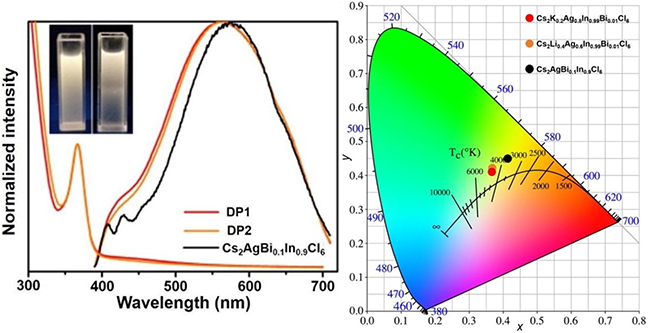Stable and efficient white-light emission is crucial for indoor illumination. Typical devices with white-light emission suffer from obvious drawbacks such as poor color rendition, efficiency losses.
White-light emission of a single source materials can solve these drawbacks. Previously, scientists observed the white-light emissions from self-trapped excitons (STEs) of single-phase low dimensional lead-perovskites. Unfortunately, the toxicity of lead is a threat to the environment and human.
Although several lead-free double perovskites with STE photoluminescence (PL) have been reported, the double perovskite nanocrystals (NCs) which exhibit efficient and broadband white-light emission is absent.
A research team led by Prof. HAN Keli from the Dalian Institute of Chemical Physics (DICP) of the Chinese Academy of Sciences synthesized lead-free double perovskite NCs with broadband white-light emission by engineering STE.
The results were published in Science Bulletin.

PL and CIE image of Cs2AgBi0.1In0.9Cl6 and K+/Li+ doped NCs (Image by CONG Muyu and YANG Bin)
The scientists studied the charge-carriers dynamic of STE for Cs2AgBiCl6 (indirect) and Cs2AgBi0.1In0.9Cl6 (direct) in order to understand the influence of bandgap type on STE PL.
They found that the phonon-assisted absorption and recombination process might induce strong carrier-phonon coupling effect in indirect bandgap NCs, resulting in non-radiative recombination of STEs, responsible for undetectable PL at room temperature. While the strength of moderate exciton-phonon coupling for direct bandgap perovskite produced radiative STEs, which exhibited bright broadband STE PL.
The scientists further incorporated K+ and Li+ into direct bandgap NCs and found that the bandgap of obtained NCs was still direct. According to the transient absorption spectrum, the process of non-radiative recombination in K+/Li+ doped NCs was further suppressed according to the transient absorption spectrum. Therefore, the higher photoluminescence quantum yield and the broader PL could be observed for K+/Li+ doped NCs.
In addition, the scientists formulated simple LEDs using K+/Li+ doped NCs.
This work may further highlight the understanding of STEs in lead-free perovskites and guide the design of lead-free perovskite NCs with bright broadband white-light emission.
This work was supported by the National Natural Science Foundation of China, the National Key Research and Development Program of China, and the Science Challenging Program. (Text by CONG Muyu and YANG Bin)